 Software Tutorial
Software Tutorial
 Office Software
Office Software
 How to use the if multiple function in Excel to create employee annual leave table
How to use the if multiple function in Excel to create employee annual leave table
How to use the if multiple function in Excel to create employee annual leave table
php editor Xigua is here to introduce to you how to use the if function in Excel to create an employee annual leave table. The if function is one of the most commonly used functions in Excel. It can judge and filter data based on certain conditions. When making an employee annual leave table, we can use the if function to determine whether the employee's number of leave days meets the annual leave requirements, and fill the results into the corresponding cells. Using the if function can save us time and energy and make making annual leave tables more efficient and accurate. Next, let’s discuss the specific operation methods together!
1. Clarify the relevant regulations and implementation rules for annual leave. That is, employees who have worked for 1 year but less than 10 years in total are entitled to 5 days of annual leave; employees who have been working for 10 years but less than 20 years are entitled to 10 days of annual leave; employees who have been working for 20 years or more are entitled to 15 days of annual leave. Under one of the special circumstances, annual leave cannot be taken.
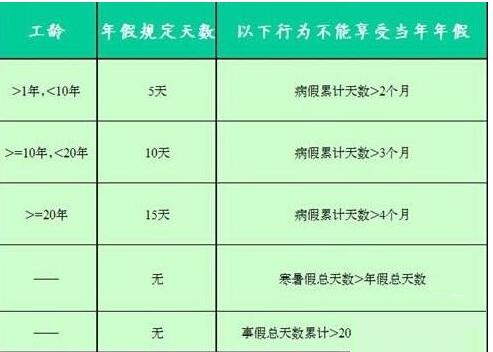
2. Create a new excel form and enter the form name, serial number, job number, name, gender, date of employment and other relevant information.
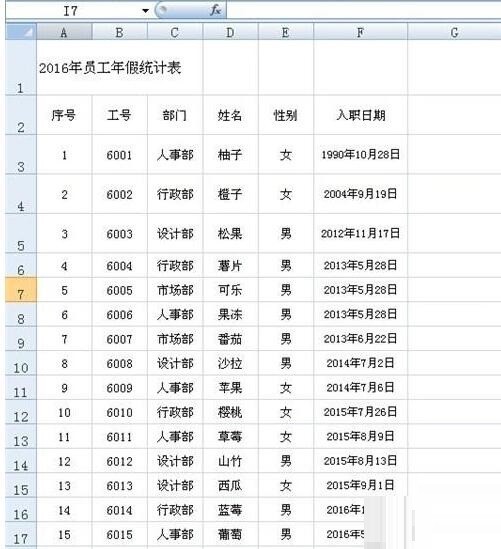
3. Enter [length of service (years)" in cell G2, enter the formula in cell G3: =DATEDIF(F3,TODAY(),"y"), and press [Return] Car/enter] can calculate the employee's length of service. Among them, the DATEDIF function is to calculate the corresponding value from the start date to the end date. In F3, the entry date is the starting time, TODAY() is the current date, and Y is the number of years of service .
After entering the formula, click with the mouse and when the symbol appears in the lower right corner of the G3 cell, drag it down to fill in the formula and calculate the length of service of all employees.
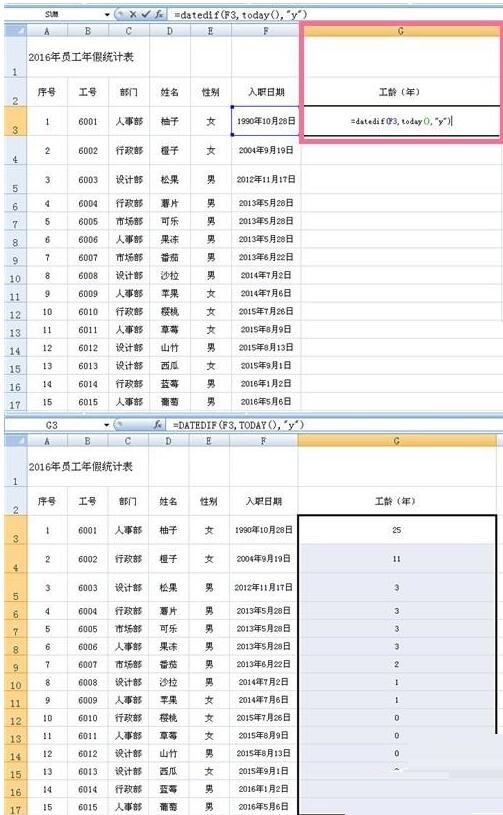
4. There are two algorithms for annual leave days.
The first one is to enter [annual leave days" in cell H2 and the formula in cell H3: =LOOKUP(G3,{0,1,10,20} ,{0,5,10,15}), press [Enter/Enter] to calculate the number of annual leave days for employees. Among them, the LOOKUP function is to find matching conditions and fill in the corresponding data. The array {0,1,10,20} refers to the node data in the length of service, and the array {0,5,10,15} is the number of annual leave days under the corresponding length of service. Braces {} can be entered using shift [/shift]. Note that in English mode, or after entering the formula, press CTRL SHIFT ENTER to complete.
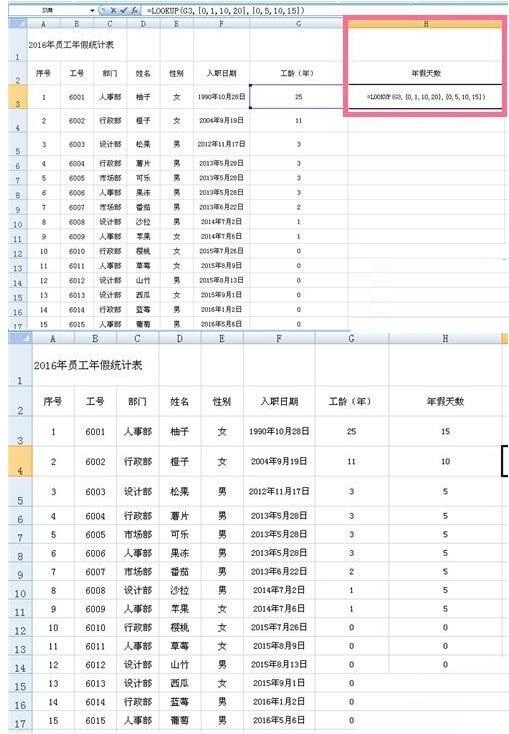
The second algorithm for annual leave days, enter the formula in cell H3: =IF(G3
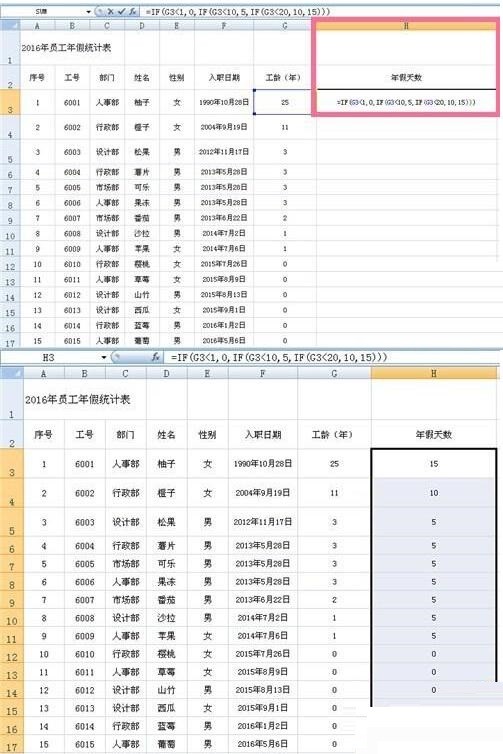
5. Finally, in order to highlight the difference in annual leave days, you can select a format through [Conditional Formatting]-[Data Bar]. Then, by adjusting the font and alignment, the entire table is completed.
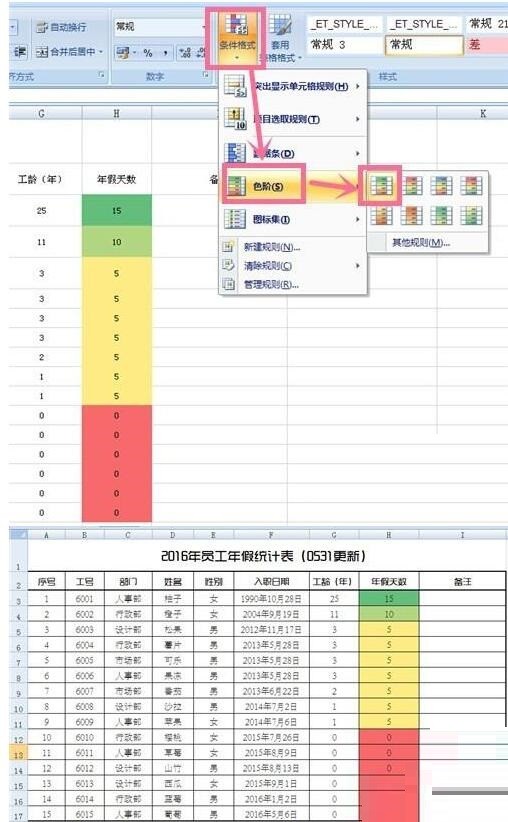
Note:
The braces {} in the array can be entered using shift [ and shift ]. Note that in English mode, or after entering the formula, press CTRL SHIFT ENTER to complete.
The above is the detailed content of How to use the if multiple function in Excel to create employee annual leave table. For more information, please follow other related articles on the PHP Chinese website!

Hot AI Tools

Undresser.AI Undress
AI-powered app for creating realistic nude photos

AI Clothes Remover
Online AI tool for removing clothes from photos.

Undress AI Tool
Undress images for free

Clothoff.io
AI clothes remover

Video Face Swap
Swap faces in any video effortlessly with our completely free AI face swap tool!

Hot Article

Hot Tools

Notepad++7.3.1
Easy-to-use and free code editor

SublimeText3 Chinese version
Chinese version, very easy to use

Zend Studio 13.0.1
Powerful PHP integrated development environment

Dreamweaver CS6
Visual web development tools

SublimeText3 Mac version
God-level code editing software (SublimeText3)

Hot Topics
 How to Create a Timeline Filter in Excel
Apr 03, 2025 am 03:51 AM
How to Create a Timeline Filter in Excel
Apr 03, 2025 am 03:51 AM
In Excel, using the timeline filter can display data by time period more efficiently, which is more convenient than using the filter button. The Timeline is a dynamic filtering option that allows you to quickly display data for a single date, month, quarter, or year. Step 1: Convert data to pivot table First, convert the original Excel data into a pivot table. Select any cell in the data table (formatted or not) and click PivotTable on the Insert tab of the ribbon. Related: How to Create Pivot Tables in Microsoft Excel Don't be intimidated by the pivot table! We will teach you basic skills that you can master in minutes. Related Articles In the dialog box, make sure the entire data range is selected (
 You Need to Know What the Hash Sign Does in Excel Formulas
Apr 08, 2025 am 12:55 AM
You Need to Know What the Hash Sign Does in Excel Formulas
Apr 08, 2025 am 12:55 AM
Excel Overflow Range Operator (#) enables formulas to be automatically adjusted to accommodate changes in overflow range size. This feature is only available for Microsoft 365 Excel for Windows or Mac. Common functions such as UNIQUE, COUNTIF, and SORTBY can be used in conjunction with overflow range operators to generate dynamic sortable lists. The pound sign (#) in the Excel formula is also called the overflow range operator, which instructs the program to consider all results in the overflow range. Therefore, even if the overflow range increases or decreases, the formula containing # will automatically reflect this change. How to list and sort unique values in Microsoft Excel
 If You Don't Rename Tables in Excel, Today's the Day to Start
Apr 15, 2025 am 12:58 AM
If You Don't Rename Tables in Excel, Today's the Day to Start
Apr 15, 2025 am 12:58 AM
Quick link Why should tables be named in Excel How to name a table in Excel Excel table naming rules and techniques By default, tables in Excel are named Table1, Table2, Table3, and so on. However, you don't have to stick to these tags. In fact, it would be better if you don't! In this quick guide, I will explain why you should always rename tables in Excel and show you how to do this. Why should tables be named in Excel While it may take some time to develop the habit of naming tables in Excel (if you don't usually do this), the following reasons illustrate today
 How to Format a Spilled Array in Excel
Apr 10, 2025 pm 12:01 PM
How to Format a Spilled Array in Excel
Apr 10, 2025 pm 12:01 PM
Use formula conditional formatting to handle overflow arrays in Excel Direct formatting of overflow arrays in Excel can cause problems, especially when the data shape or size changes. Formula-based conditional formatting rules allow automatic formatting to be adjusted when data parameters change. Adding a dollar sign ($) before a column reference applies a rule to all rows in the data. In Excel, you can apply direct formatting to the values or background of a cell to make the spreadsheet easier to read. However, when an Excel formula returns a set of values (called overflow arrays), applying direct formatting will cause problems if the size or shape of the data changes. Suppose you have this spreadsheet with overflow results from the PIVOTBY formula,
 Excel MATCH function with formula examples
Apr 15, 2025 am 11:21 AM
Excel MATCH function with formula examples
Apr 15, 2025 am 11:21 AM
This tutorial explains how to use MATCH function in Excel with formula examples. It also shows how to improve your lookup formulas by a making dynamic formula with VLOOKUP and MATCH. In Microsoft Excel, there are many different lookup/ref
 How to change Excel table styles and remove table formatting
Apr 19, 2025 am 11:45 AM
How to change Excel table styles and remove table formatting
Apr 19, 2025 am 11:45 AM
This tutorial shows you how to quickly apply, modify, and remove Excel table styles while preserving all table functionalities. Want to make your Excel tables look exactly how you want? Read on! After creating an Excel table, the first step is usual
 How to Use Excel's AGGREGATE Function to Refine Calculations
Apr 12, 2025 am 12:54 AM
How to Use Excel's AGGREGATE Function to Refine Calculations
Apr 12, 2025 am 12:54 AM
Quick Links The AGGREGATE Syntax






